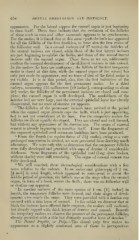Page 644 - My FlipBook
P. 644
654 DENTAL EMBRYOLOGY AND HISTOLOGY.
appearance. For the lateral nippers the enamel organ is jnst beginning
to show itself. These facts indicate that the evolution of the follicles
of these teeth in man and other mammals appears to be synchronous.
For the molars it is found that at this same epoch the bulb has appeared
for all the follicles of the first dentition, as have also the first traces of
the follicular wall. In a second embryo (of 27 weeks) the follicles of
the central incisors are closed, while those of the first lateral incisors
are just beginning to exhibit the bulbs, and those of the second lateral
incisors only the enamel organ. These facts, as we see, additionally
confirm the unequal development of the diiferent incisors in this animal.
In the molars the facts are analogous ; the follicle of the first temporary
molar is closed at this date, while the enamel organ of the second has
only just made its appearance, and no trace of that of the third molar is
yet visible. It is at this period, also, that the first indication of the
enamel organ appears for the first permanent molar. In a third
embryo, measuring 255 millimeters [10 inches], corresponding to about
28 T weeks, the follicles of the permanent incisors are closed and com-
plete ; the enamel organ is well developed. The ameloblasts of the
interior bed are very large, and the external epithelial layer has already
disappeared, but no trace of dentine yet appears.
" The follicles of the permanent incisors have arrived at the period
when the enamel organ already caps the bulb, which is just appearing,
but is not yet constricted at its base. For the temporary molars the
follicles are about equally developed. They are closed and well formed,
but without any appearance of the dentine cap. The organ of coronal
cement is already beginning to manifest itself. From the fragments of
the ruptured epithelial cord numerous buddings have been produced.
" From the fourth (an equine foetus of J weeks), owing to a very
31
prolonged maceration in alcohol, we were prevented from deriving much
advantage. We were only able to determine that the temporary follicles
were fully developed and provided with caps of dentine of considerable
thickness. Some fragments of the epithelial cord (long since broken,
without doubt) were still remaining. The organ of coronal cement was
fully developed.
" We will conclude these chronological considerations with a few
notes relative to the rodents. In an embryonal guinea-pig of 2 cm.
[4 incli] in total length, Avhich appeared to correspond to about the
middle period of gestation, the follicle was at the stage when the enamel
organ, in form of a hood, covers the bulb ; there was no follicular wajl
or dentine cap apparent.
''In another embryo of the same species of 4 cm. [H inches] in
length, the temporary follicles were formed, aud their stages of devel-
opment were nearly the same. They were provided with a dentine cap
covered with a thin layer of enamel. In the rabbit we discover that at
birth the incisors have effected their eruption, the molars still enclosed,
but already capped with thick layers of dentine and enamel. Beneath
the temporary molars we observe the presence of tiie pennanent follicles,
already ]>rovided with a thin but distinctly manifest layer of dentine."
The Dental Papilla, or Pulp.—The dental pulp first makes its
•appearance as a slightly condensed area of tissue in juxtaposition


